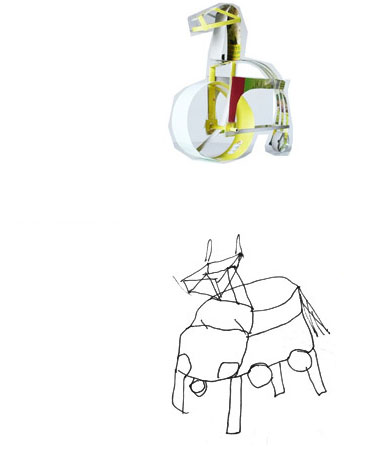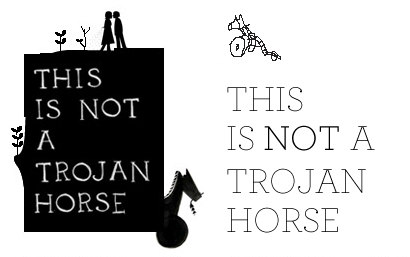
“I farm because…”
This and other questions were posed by This is Not a Trojan Horse, a large, human-powered, wooden horse designed by Futurefarmers with architect Lode Vranken. Built at Pollinaria in Abruzzo, Italy, the project emerged as a vehicle for social and material exchange at a pivotal moment in this region. Context: A few decades ago wild horses roamed free in Abruzzo and agriculture was a thriving and predominant occupation. Now big box stores, parking lots and gas stations are quickly taking place of pastures and cultivated land, while modern-day agricultural standards threaten the nuances of traditional production. Nearby cities lure the young, leaving the aging farming population without a generational change of guard. The region gained a momentary spotlight on the world stage during the earthquake of L’Aquila in 2009 and shortly thereafter the G8 summit, undergoing important changes within a very short time. Abruzzo becomes the pasture where This is Not a Trojan Horse wanders freely on a 10-day tour collecting traces of rural practices; seeds, tools and products to enliven the imaginations of farmers through discourse, artistic production and to parade their truths to power. The idea of the Trojan Horse becomes a significant modus operandi for contemporary society, beyond the symbol embedded in the historical-mythical event. Upon return to Pollinaria collected seeds will be planted to symbolize the collective memory of the tour and to celebrate local biodiversity. .................................................................................. Form: Normally we make architecture and space by defining the borders, walls, floors ... Borders define a space in which we organize social interaction. Mostly we create a physical exterior for a social interior happening; Rooms, spaces... A static structure that has an emptiness inside for possible programmed human interaction. The Trojan Horse had such interior in its belly. But that belly was a place for soldiers. This is not a Trojan Horse turns all of this inside out. The horse is not a symbol of war, but rather community. The inside is a place for gathering. It’s a sphere where the “in between” between people becomes the center rather than the individual. The moment people come together there is a “with” that makes them community, one united subject. The architectural space becomes being together. This architectural construction has no inside. This in not a building that defines social space inside borders. This is Not Trojan Horse is a centre instead of a border. The social space is formed around the object as a concentric circle without borders. It becomes a physical space with moving edges. The architecture loses its physical function as defining the edges of social space as it folds inside out. This is Not Trojan Horse is moving. It is not a center, but a nomadic physical structure in a physical network, moving around in this rural area, creating a new physical network. By its moving, the Horse makes the social meeting place it was before into a social rhizome. The architectural space now exceeds its own construction and becomes virtual possibilities for new social interaction. Local tradition becomes global renewal. The physical structure looses its' dimension and start to form a scaleless physical space. This is not a Trojan Horse is a sort of architecture that through the constructive and physical new social possibilities emerge– a new form of rhizomatic thinking about architecture where the body disappears in a nomadic social group subject. The structure gives reason to the creation of new social and political “concepts” in the Abruzzo region and further, … on the net, in the minds of the people it meets… It becomes new thinking, a resistance to the traditional discourse...bio politics. Various forms of power merge within the design of This is Not a Trojan Horse: human power, bike power, and animal power. While the horse wanders around, it stops in places, villages and farms where it leaves its memories and common ideas behind while gathering them simultaneously. The horses’ "skin" is covered with chalkboards to document perspectives contributed by locals about the future of farming and to record relevant news. The horse becomes a roaming newspaper where the news comes directly, unedited, unmediated from the authors who speak it-– from the horse’s mouth. .................................................................................. * The main source of inspiration for this work is Epios: A Sculptor by Cooley Windsor written in 2008. Windsor tells the story of the Trojan Horse through the architect appointed by Agamemnon. ..................................................................................





